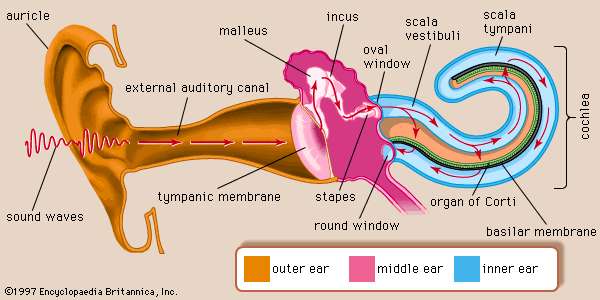
- Human ear is concerned with two functions:
- Hearing
- Equilibrium of the body
- The auditory apparatus, concerned with hearing is innervated by cochlear nerves which transmit the impulse from inner ear to the brain.
- The auditory system is organized to detect several aspects of sound, including pitch, loudness, and direction.
- The combined efforts of the anatomical components; the external ear, the middle ear and the inner ear help in auditory response in our body.
- Sound is a mechanical wave and it gets transmitted with the alternating compression and decompression of the medium (usually air) through which it is passing.
- The gradual transmission of sound waves through our ear is briefly described below:

- Sound waves are pressure waves that enter the external ear. After crossing the external auditory meatus, the waves reach the tympanic membrane (ear drum).
- Air molecules under pressure cause the tympanic membrane to vibrate. Low frequency sound waves produce slow vibrations, and high frequency waves produce rapid vibrations. The vibrations move the malleus which is in direct contact with the ear drum but on the other side.
- The handle of the malleus articulates with the incus, causing it to vibrate.
- The vibrating incus moves the stapes as it oscillates into and out of the cochlea at the oval window.
- The sound waves that reach the inner ear through the oval window cause the perilymph in the scala vestibuli to vibrate due to the change in pressure.
- Vibrations in the perilymph are transmitted across the vestibular membrane to the endolymph of the cochlear duct and also up the scala vestibuli and down the scala tympani. The vibrations are transmitted to the basilar membrane, causing the membrane to ripple.
- The fundamental vibratory ripples result in the perception of pure tones. Overtones such as musical sounds, chords, and harmonics result from secondary vibrations superimposed on the fundamental vibrations of the spiral organ.
- The ripples in the long axis of the basilar membrane are concerned with the frequency and intensity of sound. The spiral organ is organized so that the high tones are encoded near the base, and the low tones are encoded near the apex of the cochlea. Loudness is associated with the amplitude of the vibrations (the amount of displacement of the basilar membrane).
- Receptor hair cells of the spiral organ that are in contact with the overlying tectorial membrane are bent, causing them to generate graded receptor (generator) potentials. These generator potentials excite the cochlear nerve to generate action potentials. When the hairs are displaced toward the basal body (axis of sensitivity), the hair cells are excited; when the hairs are displaced away from the basal body, the hair cells are inhibited.
- The nerve impulses are conveyed along the cochlear branch of the vestibulocochlear nerve. These fibers activate the auditory pathways in the central nervous system, which terminate in the auditory area of the temporal lobe of the cerebral cortex, where the appropriate sound is perceived.
- Vibrations in the scala tympani are dissipated out of the cochlea through the round window into the middle ear.